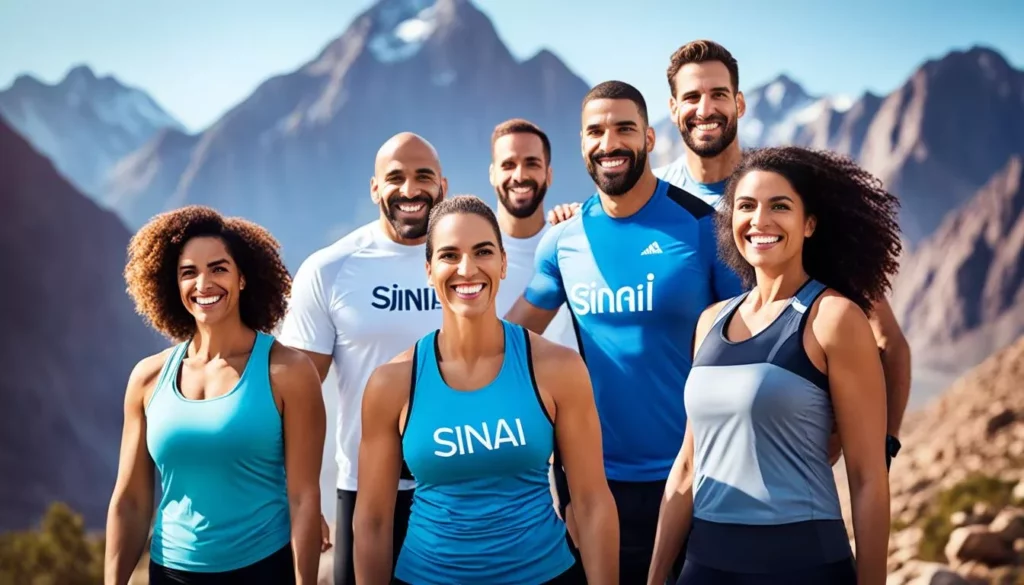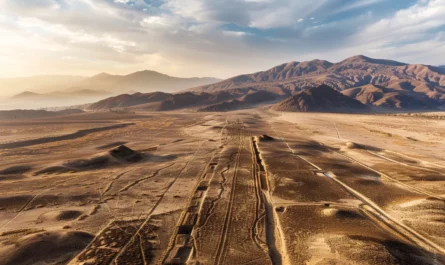Did you know that most chronic diseases can be stopped with the right diet and exercise? By following Mount Sinai’s health and wellness advice, you can improve your health and energy.
The Mount Sinai Fit Cookbook is full of healthy recipes. It uses colorful fruits and veggies, which are full of vitamins, minerals, and phytochemicals. It also focuses on whole grains and foods that help you stay hydrated.
Mount Sinai’s health advice is about more than just what you eat. It includes planning healthy lunches, eating mindfully, and getting good sleep. It’s important to exercise regularly to keep your body in shape.
Start your Mount Sinai wellness journey today. Learn how to take care of your body and mind with these easy but powerful tips.
Introduction to Mount Sinai’s History and Significance
Mount Sinai is a major point of interest in history, culture, and religion. It draws attention from scholars, historians, and those seeking spiritual insight. This makes it an important place that people worldwide are curious about.
The Rich Historical Background
Mount Sinai has a long history that goes back to ancient times. It was a key spot for many civilizations. It has seen many crucial events, which are part of the larger human story. Studying Mount Sinai helps us learn about ancient cultures and their achievements.
Cultural and Religious Significance
Mount Sinai is important in Judaism, Christianity, and Islam. Its significance comes from events like Moses getting the Ten Commandments there. Many people feel a deep spiritual connection at this site. It shows our common search for understanding with the divine.
Interesting Facts About Mount Sinai
The mountain is also important for scientific research. It is in Egypt’s Sinai Peninsula and plays a role in conserving history and promoting eco-friendly tourism. Efforts to protect Mount Sinai help maintain its beauty for inspiration.
| Aspect | Details |
|---|---|
| Height | 2,285 meters (7,497 feet) |
| Location | Sinai Peninsula, Egypt |
| Religious Significance | Moses received the Ten Commandments |
| Research | Botanical and Geological Studies |
Learning about Mount Sinai offers valuable insights into our shared past. Ongoing research on Mount Sinai continues to reveal new information about this iconic landmark.
The Best Locations to Visit in Mount Sinai
Mount Sinai has deep spiritual meaning. It also has beautiful sights and natural wonders. This place mixes history, amazing views, and work to keep it beautiful for the future.
Top Tourist Attractions
Many sights in Mount Sinai stand out, but St. Catherine’s Monastery is special. This old Christian monastery is not just about religion. It also shows off ancient building styles.
The Mount Sinai peaks are special for spiritual seekers. They can walk paths taken by famous characters from history.
Natural Wonders and Scenic Spots
Mount Sinai is full of natural beauty that attracts people from all over. Its wild lands and quiet deserts are perfect for taking photos. A must-see is the breathtaking sunrise from the top.
Conservation Efforts
Keeping Mount Sinai’s beauty and historical sites safe is very important. Many projects work to protect its special natural and historical areas. By visiting, tourists help with these conservation projects. Every visit helps keep this sacred place safe for the future.
Mount Sinai Travel Guide: Tips and Tricks
For a great visit to Mount Sinai, use an expert travel guide full of tips and tricks. Know the best time to visit, what to pack, and how to stay safe. This way, your trip will be fun and life-changing.
Best Time to Visit
When you go to Mount Sinai matters a lot. The best times are from late September to early November and late February to early April. The weather is nicer then, not too hot or too cold. So, you can really enjoy Mount Sinai’s beauty.
Travel Essentials
Think about what you’ll need for your trip. Being well-prepared makes your visit better. Here are some key items:
- Comfortable hiking shoes: You’ll need them for walking on rocky paths.
- Layered clothing: It helps with the big temperature changes.
- Reusable water bottle: Important for staying hydrated in the dry climate.
- Sun protection: Sunglasses, hats, and sunscreen are vital.
- First aid kit: Just in case of small injuries or issues.
Safety Measures and Local Etiquette
Know about safety and local rules for a good visit. Here are some tips:
- Stay hydrated: It’s easy to get dehydrated in the desert.
- Respect local customs: Dress properly and be mindful at religious spots.
- Travel in groups: Hiking with others or a guide is safer.
- Check weather conditions: Don’t hike if bad weather is expected.
- Leave no trace: Keep the place clean and respect nature.
Your Ultimate Wellness Guide: Nutrition Tips
Want to boost your health? Pay attention to what you eat and drink. Our wellness guide gives you tips to increase your energy and improve well-being.
The Benefits of Eating the Rainbow
Eat the rainbow is a fun nutrition tip. It means adding many colorful fruits and veggies to your meals. Each color gives you different nutrients and antioxidants. These are key for staying healthy and fighting diseases.
Red foods like strawberries have lycopene and vitamin C. Green veggies like spinach are full of iron and calcium.
Power Foods to Energize Your Day
Begin your day with power foods for energy and focus. Foods like quinoa, chia seeds, and Greek yogurt are rich in protein and fiber. They power you up, aid muscle recovery, and help keep your diet balanced.
Hydration: The Key to Wellness
Hydration is vital for good health. Drinking water is key, but eating foods like cucumbers and watermelon helps too. These not only hydrate but also supply important vitamins and minerals. They support digestion, skin health, and more.
Cucumber, watermelon, and oranges do more than refresh. They’re key for staying hydrated and getting nutrients.
Adding these tips to your daily life promotes balanced and healthy eating. Remember, even small changes can make a big difference in your health.
| Nutrition Tip | Example Foods | Benefits |
|---|---|---|
| Eat the Rainbow | Strawberries, Spinach, Carrots | Rich in Vitamins, Antioxidants |
| Power Foods | Quinoa, Chia Seeds, Greek Yogurt | High in Protein, Fiber, Healthy Fats |
| Hydration | Cucumbers, Watermelon, Oranges | Improves Digestion, Skin Health |
Focus on Fitness: Staying Active with Mount Sinai Tips
Staying active is key to good health. Mount Sinai offers ways to help you keep moving. Learn how to add exercise and mindfulness to your day.
Simple Steps to Incorporate Walking into Your Day
Walking is easy and good for you. Try to walk more by taking breaks to go around, choosing stairs over elevators, and walking more at lunch. Walking more, like aiming for 10,000 steps a day, boosts your fitness.
Free Yoga and Pilates Classes
Mount Sinai has free yoga and Pilates for all. These classes are good for anyone, no matter their level. They make you more flexible and balanced, and link your body and mind better.
Engaging Our Senses Through Mindfulness
Mindfulness is important for fitness. It helps you focus, cuts stress, and makes you healthier. Adding deep breathing, meditation, and mindful walking to your day is easy. It leads to a healthier, active life.
Using these tips, you can live a healthier life.
Mount Sinai’s Mental Health and Stress Management Tips
To feel your best, it’s key to care for your mental health and manage stress. Mount Sinai has tips that use mindfulness, meditation, and a good sleep routine. These can help you find balance in life.

The Power of Meditation
Meditation is a top way to handle stress. It helps you focus better, feel less stressed, and find calm and peace. When you meditate often, your mental and emotional health gets better.
Developing a Consistent Sleep Schedule
Good sleep is vital for your mind. Sleeping well helps control your mood, think clearly, and stress less. Try to sleep 7-9 hours every night. Also, go to bed and wake up at the same times every day.
Mindfulness Practices
Mindfulness can really help with stress. Doing things like breathing deeply, relaxing your muscles gradually, and mindful walking keeps you in the moment. They lower anxiety and bring peace.
| Activity | Benefits |
|---|---|
| Meditation | Increases peace, reduces stress, improves focus |
| Consistent Sleep Schedule | Regulates mood, enhances cognitive function, reduces stress |
| Mindfulness Practices | Reduces anxiety, promotes tranquility, improves mental clarity |
Combining Nutrition and Mindfulness
Mount Sinai Health System has a great way to mix nutrition and mindfulness in daily life. It boosts overall well-being. Their Weight Management Program is tailored for staff and faculty. It offers expert advice on losing weight and easy tools for healthy living. These programs teach the benefits of eating mindfully, making every meal more enjoyable.
How to Practice Mindful Eating
Being fully there when you eat and using your senses to enjoy your food defines mindful eating. It involves checking your hunger with a hunger scale. This helps you understand and react to your body’s needs, leading to better food choices. This habit increases the joy of eating and supports Mount Sinai’s goal for a full-body health approach.
Sample Mindful Eating Recipes
There are sample recipes to help you eat mindfully, featuring tasty, nutritious meals. Epicured works with Mount Sinai to deliver these meals right to your door. With a 20 percent discount and free delivery for Mount Sinai employees, it’s easy to stick to a healthy diet.
- Quinoa and Avocado Salad
- Grilled Salmon with Mixed Vegetables
- Vegetable Stir-Fry with Brown Rice
Creating a Calming Dining Environment
A peaceful eating area is key for mindful eating. Simple steps like a quiet table setting, fewer distractions, and soft music make meals serene. This setting deepens your connection to your food and mood, helping you eat better.
Mount Sinai doesn’t just offer resources for mindful eating; they also have nutrition advice for employees. Registered Dietitians and Certified Diabetes Educators are there to help. They make healthy eating plans, manage diabetes, and help meet nutrition goals. This strong support network and easy meal plans show Mount Sinai’s commitment to health through nutrition and mindfulness.
Expert Advice: Tips from Mount Sinai Registered Dietitians
Seeking a healthier lifestyle? Mount Sinai’s registered dietitians have the key. They guide you to a heart-healthy, plant-based meal plan. Their advice is practical, aiming to boost health and joy in eating.
Creating a Balanced, Heart-Healthy Meal Plan
A heart-healthy meal plan helps keep your heart in top shape. Dietitians at Mount Sinai suggest eating a variety of nutrient-rich foods.
- Fruits and Vegetables: Aim to fill half your plate with colorful fruits and vegetables. They are packed with essential vitamins, minerals, and antioxidants.
- Whole Grains: Choose whole grains like quinoa, oats, and brown rice to provide long-lasting energy and fiber.
- Lean Proteins: Include lean meats, fish, beans, and legumes in your diet to support muscle repair and growth without adding excessive saturated fats.
- Healthy Fats: Opt for sources of unsaturated fats such as avocados, nuts, and olive oil to promote good cholesterol levels.
- Limit Sodium and Sugar: Be mindful of your intake of salt and added sugars, which can negatively impact heart health.
How to Build a Plant-Based Diet
Switching to a plant-based diet benefits your health and the planet. Mount Sinai’s dietitians share tips for a successful plant-based diet.
- Start Slow: Begin by incorporating more plant-based meals into your weekly routine. Consider ‘Meatless Mondays.’
- Protein Sources: Explore plant protein options such as lentils, chickpeas, tofu, and tempeh. These are versatile and can be prepared in numerous delicious ways.
- Whole Foods Focus: Emphasize whole, unprocessed foods to ensure you get the maximum nutritional benefit.
- Variety is Key: Eating a variety of plant-based foods ensures you get a comprehensive range of nutrients.
- Supplement Wisely: Consult with a dietitian about potential supplements such as vitamin B12 or iron that may be necessary when relying heavily on plant-based sources.
Following these tips from Mount Sinai’s dietitians will greatly help in living a healthier, heart-friendly life.
Strategies for Managing Diabetes with Mount Sinai’s Resources
Mount Sinai offers many resources for those with diabetes. They focus on care that’s tailored to you and based on solid research. Their approach is wide-ranging, featuring top nutrition practices and the innovative Livongo Diabetes Program.
Effective Nutritional Practices
Good nutrition is key in managing diabetes. Mount Sinai’s resources help you plan meals with balanced nutrients. Eating high-fiber veggies, lean proteins, and whole grains helps keep your blood sugar stable.
They teach you to choose your food wisely. It’s all about portion control and eating with awareness to avoid glucose spikes. Their full diet plan is a basic part of managing diabetes.
Benefits of the Livongo Diabetes Program
The Livongo Diabetes Program changes the game for people with diabetes. This program offers feedback on your blood sugar instantly. It gives diabetes coaching and tailored advice through an easy-to-use app. Livongo’s program of ongoing care helps you make smart health choices, greatly improving your life.
The mix of technology and personal support fits right in with Mount Sinai’s mission. They’re all about leading-edge resources for managing your health.
Here’s a direct comparison of old-school diabetes management and what Livongo offers:
| Traditional Management | Livongo Diabetes Program |
|---|---|
| Manual glucose monitoring | Real-time digital feedback |
| Infrequent specialist visits | 24/7 diabetes coaching |
| Knowledge based on patient effort | Personalized insights through technology |
| Limited dietary guidance | Comprehensive dietary plans |
| Reactive care | Proactive support |
Using Mount Sinai’s resources with the Livongo Diabetes Program gives a thorough, forward-looking way to manage diabetes. Regularly using these methods controls the condition well. It also boosts your overall health.
Success Stories: Journey to Wellness at Mount Sinai
Explore touching wellness stories from people who joined Mount Sinai’s wellness journey. These tales show how health plans and support can truly change lives.

Inspiring Personal Wellness Stories
Everyone’s path to wellness at Mount Sinai is different. Yet, all share elements of hard work, tailored wellness programs, and a complete approach to health. People have beaten long-term illnesses and reached health goals, thanks to Mount Sinai’s support.
These stories prove how personal wellness plans, detailed healthcare, and community backing can lead to better health.
How Mount Sinai Supports Employee Wellness
Mount Sinai really cares about its employees’ well-being. They offer help to lead a balanced, healthy life. There’s nutritional advice, exercise classes, and help for mental well-being.
| Support Program | Description | Benefits |
|---|---|---|
| Nutrition Counseling | Personalized diet plans and advice from registered dietitians | Improved dietary habits and overall health |
| Fitness Programs | Access to free yoga and Pilates classes | Enhanced physical fitness and reduced stress |
| Mental Health Support | Meditation workshops and mental health resources | Better stress management and mental clarity |
| Employee Wellness Initiatives | Group wellness challenges and educational seminars | Strengthened community and motivation for healthy habits |
Conclusion
Learning about Mount Sinai’s story and cultural roots can start a health and wellness journey. Our guide helps you make smart health choices. Mount Sinai supports you, whether you want to eat better, move more, or practice mindfulness.
Mount Sinai’s wellness path also helps protect its natural beauty. By working on conservation, we keep Mount Sinai amazing for future generations. We encourage you to live sustainably and care for this unique place.
Exploring Mount Sinai makes you part of a community focused on health and the environment. Mount Sinai’s tools aim to improve your whole self. This journey can boost your health and help save a historically important site.
Source Links
- https://www.mountsinai.org/files/MSHealth/Assets/HS/Wellness/2021-RYP-Weekly-Wellness-Nutrition-Tips-Plus-Recipes.pdf
- https://www.mountsinai.org/files/MSHealth/Assets/Mount Sinai Fit/MSHSFitNewsletter-0317.pdf
- https://www.mountsinai.org/files/MSHealth/Assets/HS/Wellness/MSHS-CalmFit-Newsletter-Summer-2023.pdf




